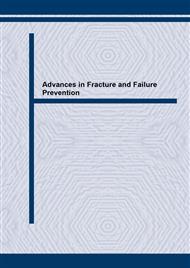p.159
p.165
p.171
p.177
p.183
p.189
p.195
p.201
p.207
Effect of Constraint on the Initiation of Ductile Fracture in Shear Loading
Abstract:
Research studies for mode I cracks have shown that fracture toughness or the critical value of J for fracture initiation, Jcrit is not merely a material property but depends also on the geometry and loading configurations. The geometry dependency of fracture toughness can be attributed to the effect of the crack tip constraint. In this paper, the constraint effect is studies for the initiation stage in mode II ductile crack growth. Two major mechanisms of ductile fracture: 'void growth and coalescence' and 'shear band localization and de-cohesion' are considered. A boundary layer model is simulated using the finite element method and the effect of far-filed T-stress on the relevant stress parameters near the crack tip is studied. It is shown that the initiation of the ductile crack growth in mode II is influenced significantly by T for the mechanism of void growth and coalescence and is insensitive to T for the mechanism of shear localisation and de-cohesion.
Info:
Periodical:
Pages:
183-188
Citation:
Online since:
April 2004
Authors:
Keywords:
Price:
Сopyright:
© 2004 Trans Tech Publications Ltd. All Rights Reserved
Share:
Citation:


